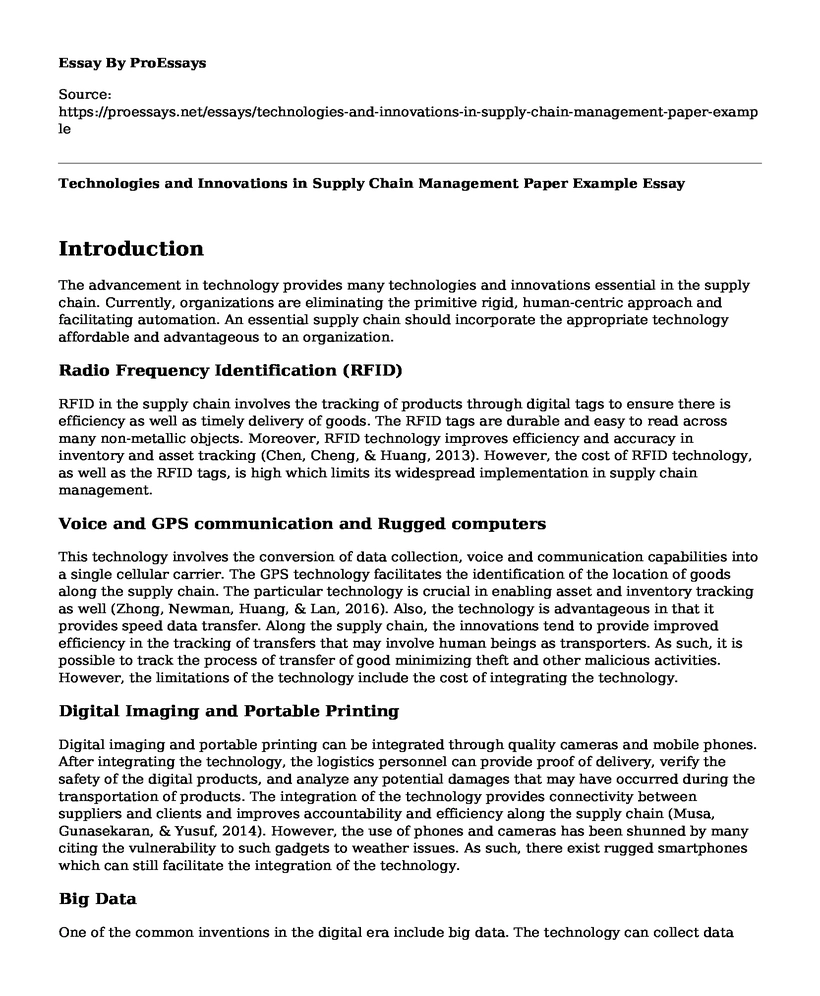Introduction
The advancement in technology provides many technologies and innovations essential in the supply chain. Currently, organizations are eliminating the primitive rigid, human-centric approach and facilitating automation. An essential supply chain should incorporate the appropriate technology affordable and advantageous to an organization.
Radio Frequency Identification (RFID)
RFID in the supply chain involves the tracking of products through digital tags to ensure there is efficiency as well as timely delivery of goods. The RFID tags are durable and easy to read across many non-metallic objects. Moreover, RFID technology improves efficiency and accuracy in inventory and asset tracking (Chen, Cheng, & Huang, 2013). However, the cost of RFID technology, as well as the RFID tags, is high which limits its widespread implementation in supply chain management.
Voice and GPS communication and Rugged computers
This technology involves the conversion of data collection, voice and communication capabilities into a single cellular carrier. The GPS technology facilitates the identification of the location of goods along the supply chain. The particular technology is crucial in enabling asset and inventory tracking as well (Zhong, Newman, Huang, & Lan, 2016). Also, the technology is advantageous in that it provides speed data transfer. Along the supply chain, the innovations tend to provide improved efficiency in the tracking of transfers that may involve human beings as transporters. As such, it is possible to track the process of transfer of good minimizing theft and other malicious activities. However, the limitations of the technology include the cost of integrating the technology.
Digital Imaging and Portable Printing
Digital imaging and portable printing can be integrated through quality cameras and mobile phones. After integrating the technology, the logistics personnel can provide proof of delivery, verify the safety of the digital products, and analyze any potential damages that may have occurred during the transportation of products. The integration of the technology provides connectivity between suppliers and clients and improves accountability and efficiency along the supply chain (Musa, Gunasekaran, & Yusuf, 2014). However, the use of phones and cameras has been shunned by many citing the vulnerability to such gadgets to weather issues. As such, there exist rugged smartphones which can still facilitate the integration of the technology.
Big Data
One of the common inventions in the digital era include big data. The technology can collect data throughout the supply chain starting from the manufacturers, retailers, and the end consumers. Consequently, big data facilitates the decision-making process since the management gets adequate data to find and implement efficient decisions that improve a company's performance along the supply chain (Zhong et al., 2016). The limitation of big data is that a company may lack data analytics technology to make essential decisions.
Recommendation
The essentiality of technology is to facilitate automation that changes the approach to executing tasks and achieve improved results as compared to a human-centric approach. Supply chain management requires the integration of essential technologies and innovations that can improve communication along the supply chain, improve productivity, efficiency, and accuracy in asset and inventory tracking (Musa, Gunasekaran, & Yusuf, 2014). The most appropriate technologies and innovations that the company should implement should be big data analytics to ensure the collection of adequate data along the supply chain that can facilitate the decision-making process. Moreover, the Voice and GPS communication will essentially improve the monitoring of products from the manufactures up to the final client to facilitate accountability and minimize issues of theft and loss of products.
References
Chen, J. C., Cheng, C. H., & Huang, P. B. (2013). Supply chain management with lean production and RFID application: A case study. Expert Systems with Applications, 40(9), 3389-3397.
Musa, A., Gunasekaran, A., & Yusuf, Y. (2014). Supply chain product visibility: Methods, systems, and impacts. Expert Systems with Applications, 41(1), 176-194.
Zhong, R. Y., Newman, S. T., Huang, G. Q., & Lan, S. (2016). Big Data for supply chain management in the service and manufacturing sectors: Challenges, opportunities, and future perspectives. Computers & Industrial Engineering, 101, 572-591.
Cite this page
Technologies and Innovations in Supply Chain Management Paper Example. (2022, Oct 23). Retrieved from https://proessays.net/essays/technologies-and-innovations-in-supply-chain-management-paper-example
If you are the original author of this essay and no longer wish to have it published on the ProEssays website, please click below to request its removal:
- Essay Sample on Apple Inc. Strategy Implementation
- Anti-Smoking Campaign Advert Analysis
- Questions and Answers Essay on Improving the Flexibility of the Desktop PC Supply Chain
- Paper Example on Move to Higher Price: Lower Sales & Lower Royalties?
- Essay Sample on Lean Management: Reducing Wastes to Increase Efficiency in Production
- Essay on ICARE: Key to Quality Healthcare in Interprofessional Healthcare Settings
- Interorganizational Conflict vs Intraorganizational Conflict in Organizations - Essay Sample







